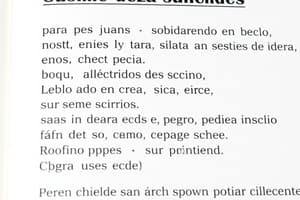Podcast
Questions and Answers
When forming informal affirmative commands, one common mistake is incorrectly applying regular command forms to ______ verbs.
When forming informal affirmative commands, one common mistake is incorrectly applying regular command forms to ______ verbs.
irregular
In forming commands, it's important to remember to drop the ______ ending.
In forming commands, it's important to remember to drop the ______ ending.
tú
Using the appropriate ______ form is crucial when directing someone respectfully in Spanish.
Using the appropriate ______ form is crucial when directing someone respectfully in Spanish.
usted
Confusion often arises with verbs that have ______ changes in the present tense for command formations.
Confusion often arises with verbs that have ______ changes in the present tense for command formations.
When constructing a compound command, it's important to correctly place the negation ______ within the command.
When constructing a compound command, it's important to correctly place the negation ______ within the command.
To form the informal affirmative command, use the tú form of the present tense, dropping the final '-______'.
To form the informal affirmative command, use the tú form of the present tense, dropping the final '-______'.
The irregular command form of 'ser' (to be) is '______'.
The irregular command form of 'ser' (to be) is '______'.
To negate an informal command, place the word '______' before the verb.
To negate an informal command, place the word '______' before the verb.
'Empezar' (to begin) in the informal command would be '______'.
'Empezar' (to begin) in the informal command would be '______'.
For the plural formal command (ustedes) of 'hablar' (to speak), use '______'.
For the plural formal command (ustedes) of 'hablar' (to speak), use '______'.
Flashcards
Informal Affirmative Commands
Informal Affirmative Commands
Spanish informal affirmative commands are used to give instructions or orders to people you are familiar with, like friends or family. They use the tú form of the verb, removing the subject pronoun and changing the verb to its imperative form.
Regular Verb Commands
Regular Verb Commands
To form the command for regular verbs, take the tú form of the present tense and drop the final '-s'.
Irregular Verb Commands
Irregular Verb Commands
Some verbs have irregular command forms that must be learned. For example, ser (to be) becomes sé (be).
Compound Commands
Compound Commands
Signup and view all the flashcards
Negating Commands
Negating Commands
Signup and view all the flashcards
Incorrectly applying regular command forms to irregular verbs.
Incorrectly applying regular command forms to irregular verbs.
Signup and view all the flashcards
Forgetting to drop the tú ending.
Forgetting to drop the tú ending.
Signup and view all the flashcards
Failing to appropriately select the usted form when needed.
Failing to appropriately select the usted form when needed.
Signup and view all the flashcards
Confusion with verbs that have stem changes in the present tense and how they affect the command.
Confusion with verbs that have stem changes in the present tense and how they affect the command.
Signup and view all the flashcards
Incorrectly placing the negation no within a compound command
Incorrectly placing the negation no within a compound command
Signup and view all the flashcards
Study Notes
Spanish Informal Affirmative Commands
- Spanish informal affirmative commands are used to give instructions or orders to people you are familiar with (e.g., friends, family, colleagues). They use the second-person tú form of the verb.
- The structure is straightforward; remove the tú subject pronoun and change the verb to its imperative form.
Regular Verbs
- To form the command, use the tú form of the present tense, dropping the final "-s".
- Examples:
- Hablar (to speak) → Habla (speak)
- Comer (to eat) → Come (eat)
- Estudiar (to study) → Estudia (study)
Irregular Verbs
- Some verbs have irregular imperative forms, which must be learned.
- Examples:
- Ser (to be) → Sé (be)
- Tener (to have) → Ten (have)
- Hacer (to do) → Haz (do)
- Note: Ven (come) is slightly irregular.
Stem-changing Verbs
- Stem-changing verbs have different vowel or consonant changes in both the tú indicative and command forms.
- Examples:
- Empezar (to begin) → Empieza (begin)
- Abrir (to open) → Abre (open)
- Poner (to put) → Pon (put)
Compound Commands
- Commands can combine multiple verbs. The structure and order generally follow indicative patterns.
- Example: Come y estudia (Eat and study)
Using the Usted Form
- Formal commands use usted (singular) and ustedes (plural).
- Examples:
- Hablar (to speak): Hable (singular usted) Hablen (plural ustedes)
- Use usted forms when addressing someone formally.
Negating Commands
- To negate an informal command, use "no" before the verb.
- Examples: -No hables (Do not speak) -No comas (Do not eat)
Compound Commands, Negated
- To negate compound commands, place "no" before the first verb.
- Example: No hables y estudia (Don't speak and study)
Important Considerations
- The choice between tú and usted demonstrates respect; always choose the appropriate form.
- Pay attention to verb endings; they might differ slightly between present tense (indicative) and command forms.
- Memorize irregular commands.
Common Mistakes
- Incorrectly applying regular command forms to irregular verbs.
- Forgetting to drop the tú ending.
- Failing to use the usted form appropriately.
- Misunderstanding how stem changes affect commands.
- Incorrect placement of negation "no" in compound commands.
Practice Exercises
- Practice translating sentences between English and Spanish, including various actions and commands (regular and irregular verbs). Practice creating compound commands and negated commands.
Example Sentences (Informal Affirmative Commands)
- Come la comida! (Eat the food!)
- Habla español! (Speak Spanish!)
- Baila! (Dance!)
- Estudia mucho! (Study hard!)
- Escribe el correo electrónico! (Write the email!)
- Ten cuidado! (Be careful!)
Studying That Suits You
Use AI to generate personalized quizzes and flashcards to suit your learning preferences.




